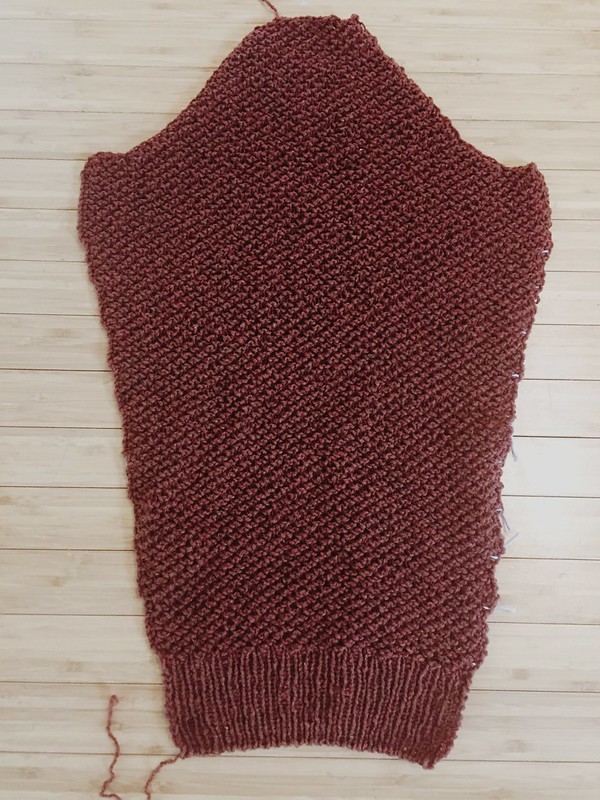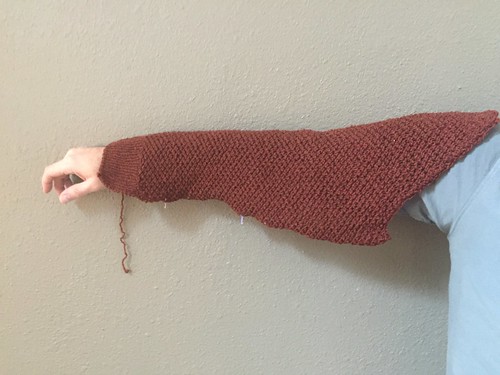I finally had to admit that I wasn't happy with the length of the sleeves on my recently-completed Sawyer Sweater. Something needed to be done.
At first I thought I could just unravel the end and rework the ribbing further up the length of the sleeve. But since I don't do this sort of thing often, I forgot you can't simply unravel the cast-on edge of a ribbed fabric piece like you can the cast-off edge. I knew this 9 years ago, but have since forgotten (see link below). Something about the moving of the yarn in front of and behind the work locks it in in that direction. It's possible to pick the yarn out through each stitch individually (which I laboriously did for a few rows), but that would eventually wear the yarn, and my patience, to a fragile thinness.
My second approach was to try and define a row on the sleeve from whence I wanted to start the cuff ribbing anew, and then cut the yarn. It's unnerving and plays havoc with the stitch count, but it's possible. I've done it before. But not this time. The nature of this pattern is such that it's very difficult to define a row in the completed work. I kept trying to run a line through what I thought was a row only to realize I was working on the diagonal, as this fabric naturally runs.
That left Plan C, which was remove the sleeves, unravel them (from the cast-off edge!) and start them over -- this time without the extra inch that I thought I'd needed the first time around and measuring more carefully. Daunting, but necessary. Ive got the first one finished and will start on the second today. As you can see, the length is coming out much better. The schematic in the pattern tells me it should be 25" long. This second attempt is 25 ¼" long. I'll take it.
It's going by pretty quickly now. I almost feel I can knit this pattern in my sleep at this stage. It's difficult to get motivated to do this kind of alteration for several reasons, among them the feeling that I should know better by now, the lovely spring weather and other planned time-sensitive knitting projects. But ultimately it feels good to be addressing this now so that it will all be squared away in 11 months when winter comes again.


Good for you! Unseaming is SUCH a pain though.
ReplyDeleteI agree on both points!
DeleteStrangely, this was pretty easy to inseam, because I used a different type and shade -- it was relatively easy to find.
ReplyDeleteThis post contributes to the reasons for my overwhelming phobia of sweaters!
ReplyDeleteI didn't mean to scare you, Kris! It's really not so bad. Try it -- just once. Something from the neck down that you can try on and adjust as you go. You can do it!
DeleteCan you say a word about the advantage of top down versus bottom up knitting? I mean, obviously, you knit the direction the pattern says to knit. But as a new knitter, I'm wondering, for instance, what problem a designer might be avoiding, or what advantage exploiting, when designing a garment.-- Siobhan
ReplyDeleteI'm by no means an expert, Siobhan, but there are are pros and cons for both types. Top down construction, which casts on at the neck, is typically done with no seams. You knit an expanding tube from the neck (with various types of shoulder shaping), leave some stitches on holders for the sleeves, continue the body, then come back and knit the sleeves down. So, an advantage for those who don't like to seam, AND, you can try it on as you go. If you have fit issues, there's no unseaming (just unraveling) to fix it.
DeleteBottom-up construction is more likely to be knit in pieces (front, back, sleeves) which are seamed later -- although not necessarily. Seaming means more finishing work at the end (which some knitters hate), but it also adds a certain amount of structural stability to the garment.
I found this page which explains some of the types of sweaters and the pros and cons of their different construction styles. It will probably answer your question better than I have!:
Pullovers for first-timers: Or, an introduction to sweater construction
Good luck!
Thanks so much! -Siobhan
Delete